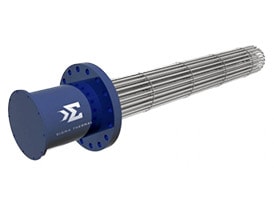Immersion Heaters
 Electric immersion heaters are typically inserted directly into a pipe, tank, or vessel to heat process gases or liquids. Since the heat is generated by electricity, virtually all of the energy is consumed by the product being heated. As a result, the liquid is heated near 100% efficiency. With standard elements constructed of Alloy 800, these heaters are designed to heat a variety of fluids and maintain corrosion resistance.
Electric immersion heaters are typically inserted directly into a pipe, tank, or vessel to heat process gases or liquids. Since the heat is generated by electricity, virtually all of the energy is consumed by the product being heated. As a result, the liquid is heated near 100% efficiency. With standard elements constructed of Alloy 800, these heaters are designed to heat a variety of fluids and maintain corrosion resistance.
Get in touch with a Sigma Thermal representative to request a quote for an immersion heater.
Design Features
Material Selection
Sigma Thermal examines each process to ensure the proper materials are selected. As a standard, flanged immersion heater elements are constructed of Alloy 800. Typical flange materials include Carbon Steel and 300 Series Stainless Steels. For maximum corrosion protection, seamless or welded and drawn elements are offered. Nickel based flange and spacer materials are also available. For highly corrosive fluids, passivation of all wetted parts is recommended.
Watt Density Selection
Watt densities range from 2 to 60 watts per square inch (.3 to 9.3 watts per square centimeter). Choosing the correct watt density is essential to the life of the heater and the fluid. The fluid’s ability to remove heat from the element will determine the proper watt density. Water removes heat from the elements very well, so a higher watt density is appropriate. Crude Oil and Molasses do not remove heat from the element well, so a much lower watt density is required.
Control Selection
Watt density and material selection is only part of the decision process. Properly selecting the control method is as critical as watt density and material selection.
SCR
SCR control panels regulate the power to the heater, reducing the watt density of the element, resulting in a cooler running heater. This reduction in watt density will prolong the life of the heater and prevent fluid degradation when flows are reduced. SCR control is recommended on gas applications and single pass flowing liquids that require tight control.
Contactor (Off/On)
Off/On control is well suited for tank applications. The immersion heater can be inserted directly into the tank or the fluid can be circulated in a closed loop. The most common applications are freeze protection and viscosity control. Since demand may vary, a stepper/sequencer is recommended to prevent rapid cycling of the contactors. The sequencer will power banks of elements as required for the demand, providing more precise control and lowering operating costs.
SCR / Contactor Combination
For many large loads, full SCR control is not practical. For these applications, a combination of SCR and contactor control is a good choice for tight control with a fluctuation demand. This is accomplished by the use of stepper/sequencer with an analog signal. As the demand increases, the SCR will “ramp up” the temperature until a full bank of contactor circuits engage. The SCR will then “ramp up” and repeat the process until steady state is accomplished.
Panel Materials
- Control Panels are available in Carbon Steel, 304SS and 316SS.
Panel Approvals
- UL, cUL, CE, ATEX, IEC ex
Heater Approvals
- UL, cUL, CSA, CE, ATEX, IEC ex








